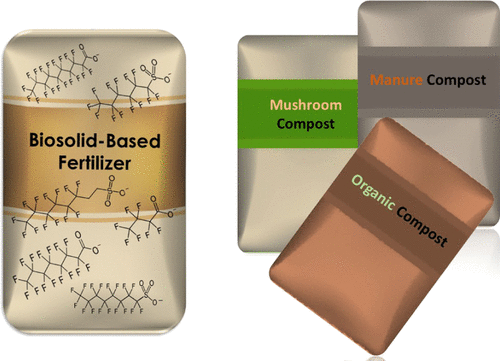当前位置:
X-MOL 学术
›
Environ. Sci. Technol.
›
论文详情
Our official English website, www.x-mol.net, welcomes your feedback! (Note: you will need to create a separate account there.)
Characterizing and Comparing Per- and Polyfluoroalkyl Substances in Commercially Available Biosolid and Organic Non-Biosolid-Based Products.
Environmental Science & Technology ( IF 11.4 ) Pub Date : 2020-06-21 , DOI: 10.1021/acs.est.9b07281 Rooney Kim Lazcano 1, 2 , Youn Jeong Choi 1, 2 , Michael L Mashtare 1, 2, 3 , Linda S Lee 1, 2, 3
Environmental Science & Technology ( IF 11.4 ) Pub Date : 2020-06-21 , DOI: 10.1021/acs.est.9b07281 Rooney Kim Lazcano 1, 2 , Youn Jeong Choi 1, 2 , Michael L Mashtare 1, 2, 3 , Linda S Lee 1, 2, 3
Affiliation

|
There is increasing concern over the presence of per- and polyfluoroalkyl substances (PFAS) in biosolids, while sales in commercially available biosolid-based products used as soil amendments are also increasing. Here, the occurrence of 17 perfluoroalkyl acids (PFAAs) present in 13 commercially available biosolid-based products, six organic composts (manure, mushroom, peat, and untreated wood), and one food and yard waste compost were studied. The PFAA concentration ranges observed are as follows: biosolid-based products (9.0–199 μg/kg) > food and yard waste (18.5 μg/kg) > other organic products (0.1–1.1 μg/kg). Analysis of 2014, 2016, and 2018 bags produced from one product line showed a temporal decrease in the total PFAAs (181, 101, and 74 μg/kg, respectively). The total oxidizable precursor (TOP) assay revealed the presence of PFAA precursors in the biosolid-based products at much higher levels, when the soluble carbon was removed by the ENVI-Carb clean-up prior to the TOP assay. Time-of-flight mass spectrometry confirmed the presence of three sulfonamides, two fluorotelomer sulfonates, and several polyfluoroalkyl phosphate diesters. Pore-water concentrations of water-saturated products were primarily of short-chain PFAAs and increased with increasing PFAA concentrations in the products. A strong positive log-linear correlation between organic carbon (OC)-normalized PFAA partition coefficients and the number of CFn units indicates that OC is a good predictor of PFAA release concentrations.
中文翻译:

表征和比较市售生物固体和有机非生物固体基产品中的全氟和多氟烷基物质。
人们越来越关注生物固体中是否存在全氟烷基物质和多氟烷基物质(PFAS),与此同时,用于土壤改良剂的市售生物固体基产品的销售也在增长。在这里,研究了13种市售生物固体基产品,6种有机堆肥(粪肥,蘑菇,泥煤和未经处理的木材)以及一种食品和庭院废物堆肥中17种全氟烷基酸(PFAA)的存在。观察到的PFAA浓度范围如下:基于生物固体的产品(9.0–199μg/ kg)>食物和庭院废物(18.5μg/ kg)>其他有机产品(0.1–1.1μg/ kg)。从一条生产线生产的2014年,2016年和2018年的包装袋分析显示,总PFAA随时间下降(分别为181、101和74μg/ kg)。总可氧化前体(TOP)分析表明,当在TOP分析之前通过ENVI-Carb净化去除可溶性碳时,基于生物固体的产品中PFAA前体的含量更高。飞行时间质谱法证实了三种磺酰胺,两种氟调聚物磺酸盐和几种多氟烷基磷酸二酯的存在。水饱和产品的孔隙水浓度主要是短链PFAA,并且随着产品中PFAA浓度的增加而增加。有机碳(OC)归一化PFAA分配系数与CF数之间的强对数线性正相关 飞行时间质谱法证实了三种磺酰胺,两种氟调聚物磺酸盐和几种多氟烷基磷酸二酯的存在。水饱和产品的孔隙水浓度主要是短链PFAA,并且随着产品中PFAA浓度的增加而增加。有机碳(OC)归一化PFAA分配系数与CF数之间的强对数线性正相关 飞行时间质谱法证实了三种磺酰胺,两种氟调聚物磺酸盐和几种多氟烷基磷酸二酯的存在。水饱和产品的孔隙水浓度主要是短链PFAA,并且随着产品中PFAA浓度的增加而增加。有机碳(OC)归一化PFAA分配系数与CF数之间的强对数线性正相关n个单位表示OC是PFAA释放浓度的良好预测指标。
更新日期:2020-07-21
中文翻译:

表征和比较市售生物固体和有机非生物固体基产品中的全氟和多氟烷基物质。
人们越来越关注生物固体中是否存在全氟烷基物质和多氟烷基物质(PFAS),与此同时,用于土壤改良剂的市售生物固体基产品的销售也在增长。在这里,研究了13种市售生物固体基产品,6种有机堆肥(粪肥,蘑菇,泥煤和未经处理的木材)以及一种食品和庭院废物堆肥中17种全氟烷基酸(PFAA)的存在。观察到的PFAA浓度范围如下:基于生物固体的产品(9.0–199μg/ kg)>食物和庭院废物(18.5μg/ kg)>其他有机产品(0.1–1.1μg/ kg)。从一条生产线生产的2014年,2016年和2018年的包装袋分析显示,总PFAA随时间下降(分别为181、101和74μg/ kg)。总可氧化前体(TOP)分析表明,当在TOP分析之前通过ENVI-Carb净化去除可溶性碳时,基于生物固体的产品中PFAA前体的含量更高。飞行时间质谱法证实了三种磺酰胺,两种氟调聚物磺酸盐和几种多氟烷基磷酸二酯的存在。水饱和产品的孔隙水浓度主要是短链PFAA,并且随着产品中PFAA浓度的增加而增加。有机碳(OC)归一化PFAA分配系数与CF数之间的强对数线性正相关 飞行时间质谱法证实了三种磺酰胺,两种氟调聚物磺酸盐和几种多氟烷基磷酸二酯的存在。水饱和产品的孔隙水浓度主要是短链PFAA,并且随着产品中PFAA浓度的增加而增加。有机碳(OC)归一化PFAA分配系数与CF数之间的强对数线性正相关 飞行时间质谱法证实了三种磺酰胺,两种氟调聚物磺酸盐和几种多氟烷基磷酸二酯的存在。水饱和产品的孔隙水浓度主要是短链PFAA,并且随着产品中PFAA浓度的增加而增加。有机碳(OC)归一化PFAA分配系数与CF数之间的强对数线性正相关n个单位表示OC是PFAA释放浓度的良好预测指标。


























 京公网安备 11010802027423号
京公网安备 11010802027423号